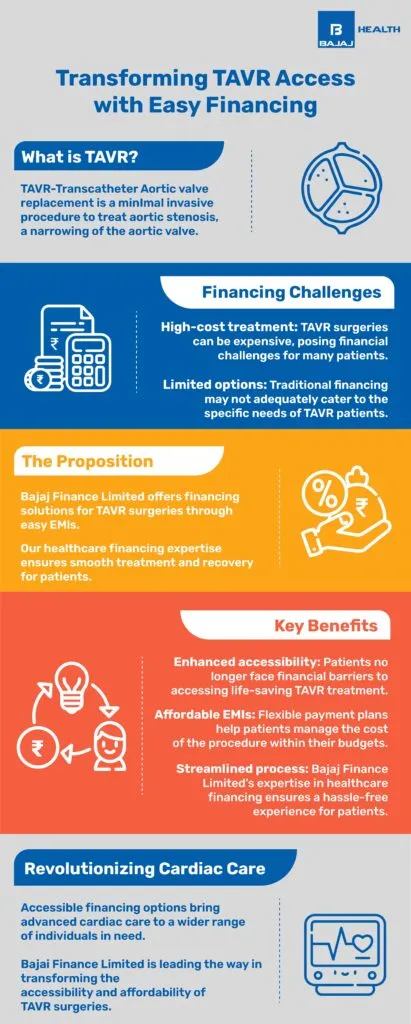Heart Health | min read
Revolutionizing Access to TAVR: Bajaj Finance Transforming Cardiac Surgeries with Easy EMIs
Medically reviewed by
Table of Content
Synopsis
TAVR (Transcatheter Aortic Valve Replacement) is a minimally invasive alternative to open-heart surgery for patients with aortic stenosis. Unlike traditional surgery, TAVR involves replacing the damaged valve through a catheter, reducing the risk and recovery time for older patients or those with additional health concerns. This transformative procedure offers renewed hope for individuals previously deemed high-risk for surgery. Bajaj Finance plays a crucial role in making TAVR accessible and affordable through their Easy EMIs, ensuring that patients can access this advanced treatment option without financial burden.
Key Takeaways
- TAVR procedure is a safer alternative to open-heart surgery for aortic stenosis
- It is a minimally invasive procedure for aortic valve replacement
- Bajaj Finance enables accessibility with Easy EMIs for TAVR procedures for patients in need
Aortic stenosis is a condition that affects the aortic valve in the heart, causing it to become narrowed and stiff. The aortic valve regulates blood flow from the heart to the rest of the body, and when it becomes limited, the heart must work harder to pump blood. Over time, aortic stenosis can lead to heart failure, chest pain, and other serious complications.
The symptoms of aortic stenosis can vary depending on the severity of the condition, but common symptoms include shortness of breath, chest pain or tightness, dizziness or fainting, fatigue, and heart palpitations. Aortic stenosis is typically caused by age-related wear and tear on the valve, but congenital defects, rheumatic fever, or other medical conditions can also cause it.
In the past, the only treatment for aortic stenosis was open-heart surgery to replace the damaged valve. However, this procedure was often too risky for older patients or those with other health issues. In recent years, a minimally invasive procedure called transcatheter aortic valve replacement (TAVR) has become available as an alternative to open-heart surgery.
TAVR is a procedure that uses a catheter to deliver a new valve to the heart through a small incision in the groin or chest. The new valve is typically made of biological tissue (such as bovine or porcine tissue) or synthetic materials, and it is compressed and delivered to the heart through the catheter. Once in place, the new valve is expanded and takes over the function of the damaged valve.
TAVR is performed in a specialized catheterization lab or hybrid operating room by a team of interventional cardiologists and cardiac surgeons. The procedure can be done under local anaesthesia with mild sedation, and it typically takes a few hours to complete. Recovery times are shorter with TAVR than with open-heart surgery, and patients can often go home within a few days.
TAVR is not suitable for all patients with aortic stenosis, and the decision to undergo the procedure is made after careful evaluation by a medical team. Patients who are considered good candidates for TAVR are typically those who are at high risk for complications from open-heart surgery, such as older patients or those with other health issues. Patients with severe aortic stenosis who are not experiencing symptoms may also be considered for TAVR.
While TAVR is generally safe and effective, it does carry some risks, including bleeding, infection, stroke, and damage to the blood vessels or heart. However, the risk of complications is generally lower with TAVR than with open-heart surgery. Patients who undergo TAVR will require regular follow-ups with their medical team to monitor their condition and ensure that the new valve is functioning correctly.

Here's a comparison of traditional surgery (open-heart surgery) and TAVR (transcatheter aortic valve replacement) for the treatment of aortic stenosis:
Invasiveness and Incision
Traditional Surgery
Open-heart surgery requires a large incision in the chest to access the heart. The breastbone is usually split, and the patient is connected to a heart-lung machine, which takes over the heart's pumping function.
TAVR
TAVR is minimally invasive and typically involves small incisions in the groin or chest. It is performed while the heart is still beating, eliminating the need for a heart-lung machine.
Anaesthesia
Traditional Surgery
Open-heart surgery is performed under general anaesthesia, which induces a state of unconsciousness.
TAVR
TAVR can be performed under local anaesthesia with mild sedation. This means the patient is awake but relaxed during the procedure.
Hospital Stay and Recovery Time
Traditional Surgery
Recovery from open-heart surgery usually requires a longer hospital stay, typically ranging from 5 to 10 days. The overall recovery period may extend for several weeks to months.
TAVR
TAVR often allows for shorter hospital stays, typically ranging from 2 to 4 days. The recovery time is generally shorter than with traditional surgery, with many patients able to resume normal activities within a week or two.
Risk of Complications
Traditional Surgery
Open-heart surgery carries a higher risk of certain complications, such as bleeding, infection, stroke, and prolonged recovery, due to the invasiveness of the procedure and the use of the heart-lung machine.
TAVR
TAVR is generally associated with a lower risk of complications compared to traditional surgery. However, it still carries risks, including bleeding, infection, stroke, and damage to blood vessels or the heart.
Patient Eligibility
Traditional Surgery
Open-heart surgery is suitable for most patients with aortic stenosis, including those with severe valve damage and various risk profiles.
TAVR
TAVR is often recommended for patients who are considered high-risk or inoperable for open-heart surgery due to age, underlying health conditions, or other factors. It is also suitable for some intermediate-risk patients and, in some instances, low-risk patients.
Long-Term Valve Durability
Traditional Surgery
Surgical valve replacements have a long history of durability, with mechanical valves potentially lasting a lifetime. Biological valves typically last 10-20 years, depending on the patient's age and other factors.
TAVR
The long-term durability of TAVR valves is still being evaluated, as it is a relatively newer procedure. However, studies suggest that TAVR valves may have a similar lifespan to surgical valves, with the potential for eventual valve degeneration requiring additional interventions.
It's essential to note that the choice between traditional surgery and TAVR depends on individual patient characteristics, such as age, overall health, and anatomical considerations. The decision is typically made through a thorough evaluation by a medical team consisting of interventional cardiologists, cardiac surgeons, and other specialists. They will consider the patient's unique circumstances to determine the most appropriate treatment approach for aortic stenosis.
Bajaj Finance has emerged as a pioneering force in the market by offering financing solutions for TAVR surgeries through easy EMIs. This has created a unique opportunity for patients seeking transcatheter aortic valve replacement, ensuring that financial constraints do not impede access to this life-saving procedure.
By combining Bajaj Finance's expertise in healthcare financing, patients now have the means to undergo TAVR with the flexibility of affordable instalment payments. This initiative addresses a critical need in the healthcare landscape, empowering patients to receive advanced cardiac care while alleviating the burden of immediate financial responsibilities. Bajaj Finance aims to revolutionize the accessibility of TAVR, making it a viable option for a broader spectrum of individuals seeking treatment for aortic stenosis.
In conclusion, aortic stenosis is a severe condition that can lead to heart failure and other complications. TAVR is a minimally invasive procedure that offers an alternative to open-heart surgery for patients with aortic stenosis who are not good candidates for traditional surgery. If you or a loved one has been diagnosed with aortic stenosis, it's essential to talk to your healthcare provider about your treatment options and whether TAVR may be a good option for you.
References
Disclaimer
Please note that this article is solely meant for informational purposes and Bajaj Finserv Health Limited (“BFHL”) does not shoulder any responsibility of the views/advice/information expressed/given by the writer/reviewer/originator. This article should not be considered as a substitute for any medical advice, diagnosis or treatment. Always consult with your trusted physician/qualified healthcare professional to evaluate your medical condition. The above article has been reviewed by a qualified doctor and BFHL is not responsible for any damages for any information or services provided by any third party.





